What will beetroot “teach” us about osmosis?
Type of resource: You tube
Web address https://www.youtube.com/watch?v=zL_-J–vTmo
Language: English, Polish
Description
Experiment – Investigating the phenomenon of osmosis and its course depending on different substances used.
Scientific concept introduced
Osmosis, measuring cup, solution, salt solution, sugar solution, salt, sugar, beetroot, water
Creative and critical thinking
Critical thinking – analyzing, comparing
Mathematical reasoning
measuring the amounts of salt and sugar, using the measuring cup
Scientific thinking
observing, predicting, drawing conclusions, formulating hypotheses
Learning how to learn
curiosity, motivation and engagement, critical reflection on one’s own learning and knowledge
Additional
A/ Enriching scientific vocabulary
B/ Teamwork
C/ Fine motor skills development, Followings the rules of safety motoryki małej.
What will beetroot “teach” us about osmosis?
Overall aims
Building the scientific concept of osmosis.
Supporting the development of scientific thinking by conducting experiments.
Creating the possibilities to cooperate in small teams.
Developing the scientific language and the abilities to support one’s own statements with arguments.
Vocabulary – keywords should be understood
Osmosis, measuring cup, solution, salt solution, sugar solution, salt, sugar, beetroot, water
Expected learning outcomes (operational aims)
The child will be able to:
– Measure the right amount of water
– Prepare the salt and sugar solutions
– Use simple kitchen tools (knife, potato peeler, measuring cup, teaspoon)
– Correctly name the phenomena and objects studied
– Perform the experiment on his own
– Analyze and draw conclusions on the basis of the conducted research
– Independently experience, observe, argue his statements (conclusions)
– Explain the phenomenon of osmosis
STEM skills – to which the learning unit is related to
CORE STEM SKILLS
Critical thinking – analyzing, comparing
Mathematical reasoning: measuring the amounts of salt and sugar, using the measuring cup
Scientific thinking: observing, predicting, drawing conclusions, formulating hypotheses
Learning how to learn: curiosity, motivation and engagement, critical reflection on one’s own learning and knowledge
ADDITIONAL SKILLS
– enriching scientific vocabulary
– teamwork,
– fine motor skills,
– following the rules of safety
Teaching methodologies/activity outline
Prepare: three red beetroots, a knife, a knife for peeling vegetables, three glasses (beakers), water, sugar, salt, measuring tape, teaspoon
Building a problem situation: show the beetroots and other materials to children, and ask if they know what it is?
Problem question: Do you know what osmosis is? Where does osmosis occur?
Formulating hypotheses: jot down the child’s predictions.
Verification of hypotheses:
carrying out the experiment in pairs or in small groups: Each group receives three beetroots. The teacher presents and explains how to cut them.
Experiment:
1. Cut the 3 beets at a height of 1/3 from the root, use a vegetable peeling knife to make a hole in the center of most of the beets (up to 2 cm),
2. pour water into 3 glasses (beakers),
3. add salt to one – 1 teaspoon, to the other 1 teaspoon of sugar, leave clean water in the third.
4. Pour into the hollow holes: to the first beet – clean water, to the second – salt solution, to the third – sugar solution.
5. Cover the beets with the top cut off earlier and leave for 24 hours to observe
Description of results and drawing conclusions: on the second day, ask the children to describe what happened? Why did this happen? What is osmosis and how does it work? Let them try to explain what osmosis is about.
Tip for the teacher. Definition of osmosis: Osmosis is a process that occurs in all living organisms. It consists in passing through the semipermeable membrane of water molecules from a solution with a lower concentration to a solution with a higher concentration of molecules.
Assessment of learning
Worksheet – a drawing documenting the effects of the experiment
Equipment and materials to be used in learning unit (tools, ingredients etc)
3 beets for one group (experience), plate with description (water, sugar solution, salt solution), chopping knife, vegetable peeling knife, three scoops (beakers) for each group, teaspoons for each group, salt, sugar
Kind of setting
Classroom
References – source
What will beetroot “teach” us about osmosis?
SOON ONLINE!
PDF: https://www.printfriendly.com/p/g/6Wkang

